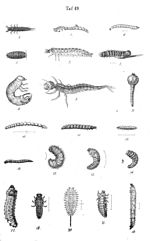Embryology facts for kids
Embryology is a part of biology that studies how living things grow and develop before they are born or hatch. It looks at how tiny cells called gametes (like sperm and egg) come together, how a new life starts through fertilization, and how an embryo and then a fetus form. Embryology also helps us understand birth defects that can happen during this early development.
Contents
How Animals Develop from an Embryo
After a fertilized egg starts dividing many times, the group of cells first forms a solid ball called a morula. This ball then becomes a hollow ball, which is called a blastula. This blastula soon develops a small opening or pore.
Different Ways Animals Develop
In animals with two symmetrical sides (like humans or insects), the blastula develops in one of two main ways. This difference helps scientists group animals.
If the first opening in the blastula becomes the animal's mouth, it's called a protostome. Most invertebrate animals, like insects, worms, and snails, are protostomes.
If the first opening becomes the animal's anus, it's called a deuterostome. This group includes vertebrates like fish, birds, and humans.
Later, the blastula changes into a more complex shape called a gastrula.
The gastrula quickly forms three special layers of cells. These are called the germ layers, and they are like the building blocks for all the different parts of the body:
- The inside layer, called the endoderm, forms organs like the stomach, intestines, and lungs.
- The middle layer, called the mesoderm, develops into muscles, bones, and the blood system.
- The outside layer, called the ectoderm, forms the nervous system (including the brain), skin, hair, and nails.
It's interesting that embryos of many different species often look quite similar in their early stages. This is because these species share a common evolutionary past. These similarities are called homologous structures. They show how different animals can have similar body parts that developed from the same basic plan in an ancient ancestor.
Human Development
Humans are deuterostomes, meaning our first embryonic opening becomes the anus.
In humans, the developing life is called an embryo from the time it attaches to the uterus wall until the end of the eighth week after conception. After the eighth week (which is about the tenth week of pregnancy), the developing human is then called a fetus.
History of Embryology
For a long time, people had different ideas about how life developed. In the 1700s, some believed in something called preformation. This idea suggested that a tiny, fully formed baby (a "homunculus") was already present in the sperm and just grew bigger.
However, another idea called epigenesis was proposed much earlier by Aristotle. This idea said that an animal's form develops gradually from a simple egg. As microscopes got better in the 1800s, scientists could see that embryos really did take shape step-by-step. This proved that epigenesis was the correct way to understand development.
Key Discoveries in Embryology
In 1827, Karl Ernst von Baer discovered the mammalian egg. He and Heinz Christian Pander also developed the idea of germ layers, explaining how the three basic cell layers form all body parts.
After the 1950s, with the discovery of DNA's structure and advances in molecular biology, a new field called developmental biology emerged. This field tries to understand how specific genes control all the amazing changes that happen as an embryo grows. It looks at which genes are responsible for each step and how they are turned on or off.
Vertebrate and Invertebrate Embryology
Many basic rules of embryology apply to both invertebrates (animals without backbones, like insects) and vertebrates (animals with backbones, like fish and mammals). Studying how invertebrates develop has helped us learn more about vertebrate development.
However, there are also many differences. For example, many invertebrate species release a larva (like a caterpillar or a tadpole) that looks very different from the adult animal. The larva then changes into the adult form later. While some invertebrates, like spiders, go straight from egg to adult, many insects go through one or more larval stages.
Images for kids
-
A study of embryos by Leonardo da Vinci.
See also
 In Spanish: Embriología para niños
In Spanish: Embriología para niños





